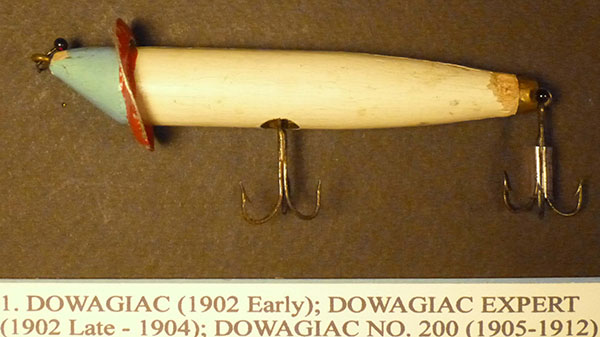By Louie Stout
 Heddon Legacy a Big Part of Michiana History
Heddon Legacy a Big Part of Michiana History
Michiana has had a hand in the making of America in so many different ways, including some fishing tackle as we know it today.
Legend has it that at the turn of the 1900s, James Heddon was carving a stick along the banks of Millpond Lake just east of Dowagiac. When he threw a sliver of wood into the water, a big bass surfaced and inhaled it.
That gave Heddon the idea to create a topwater lure because, at that time, nearly all fishing lures ran underwater. He went home and created the “Dowagiac Expert” that quickly popularized topwater fishing.
Heddon, who was more interested in fishing than owning a business, turned the job over to his son Charles who went on to build a lure manufacturing company that became one of the largest in the world.
For that and many other reasons, it was announced last week that James Heddon will be inducted into the Bass Fishing Hall of Fame in Springfield, Mo. this September.
 James HeddonAlthough the company was sold multiple times and is currently owned by PRADCO in Fort Smith, Ark., many of Heddon’s creations continue to sell well today.
James HeddonAlthough the company was sold multiple times and is currently owned by PRADCO in Fort Smith, Ark., many of Heddon’s creations continue to sell well today.
For example the Zara Spook remains a staple in bass angler’s tackle boxes while the Crazy Crawler and Lucky 13, Heddon’s original creations, are still being marketed today.
The Heddon legacy has remained relevant in Dowagiac thanks to the efforts of Don and Joan Lyons of Lyons Industries. The couple not only owns the building that once housed the Heddon plant, but also owns the largest collection of Heddon memorables and maintains a Heddon Museum at the old factory building.
Don Lyons, who has served as Dowagiac Mayor for 23 years, became the Heddon company historian and wrote a book about the company’s history.
The early years
Heddon was born in Stafford, N.Y. but his family moved to a place near Magician Lake in 1849 and into Dowagiac area as a teenager in 1860. His first business was beekeeping, and at age 22, he became the first Michigander to make a living at it and became one the largest honey producing companies in the U.S.
Lyons says that, around 1900 and at age 55, Heddon gave up beekeeping and became a fishing fanatic when a friend introduced him to high quality fishing rods and reels, the latter of which were made by watch keepers.
“He learned that he could cast lures (with silk line) 30 to 40 feet away, which was more interesting to him than fishing with a cane pole and bobber,” Lyons said.
Refined casting tackle, coupled with the introduction of the Dowagiac Expert topwater, helped transform fishing from an “uninvolved pastime” to an active sport, Lyons said.
“You could cast out lures, see the explosion as the fish would strike the lure and jump,” said Lyons. “It helped create the bass market as we know it today.”
Although James died in 1911 at the age of 66, the company flourished under Charles’ guidance.
Perhaps Heddon’s biggest success was the River Runt which sold millions and was one of the most popular diving plugs during its time. The first wooden version was made in 1928 and was Heddon’s first plastic lure in 1933.
The Heddon family sold the business to the Murchison brothers in 1951, a family that would eventually own the Dallas Cowboys. It was sold a couple more times before landing at PRADCO in 1983 and the company was moved from Dowagiac to Arkansas in July 1984.
Fact or Folklore?
Lyons research never turned up evidence that Heddon’s first topwater creation really came from that day of carving wood along the banks of Millpond.
“All of the Heddon principals were dead so I couldn’t confirm that,” he said. “The first time I saw it mentioned was in brochures printed around 1948.”
It was around that time that the late Homer Circle, who went on to become a legendary book author and columnist for Sports Afield Magazine, was Heddon’s advertising director. Circle, who was inducted into the Bass Fishing Hall of Fame in 2012, was a tremendous story teller.
“My hunch,” said Lyons, “is that a group sat around a table discussing a story to fit James Heddon’s image; something romantic about fishing that would catch people’s attention. After 1948, I began seeing that tale over and over again. It became received wisdom.”
The public boat launch on Millpond is known as James Heddon Park and a landmark notes the location of where Heddon was inspired to whittle the first topwater lure.
Truth or folklore? Who cares? What matters is Heddon blazed the trail in fishing lures and that the Bass Fishing Hall of Fame finally gave him the recognition he deserved.
And thanks to the Lyons family, you can see that history in 3,000 square foot of space at the Dowagiac Museum. For more information, visit heddonmuseum@lyonindustries.com.


